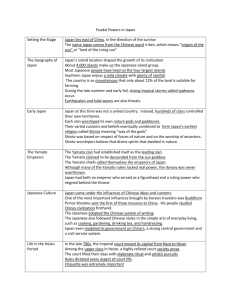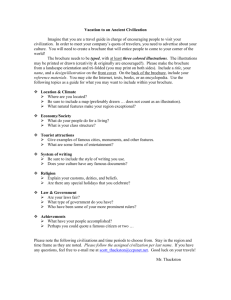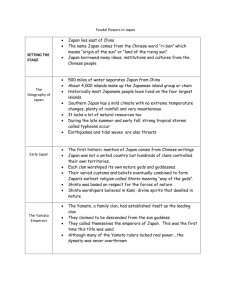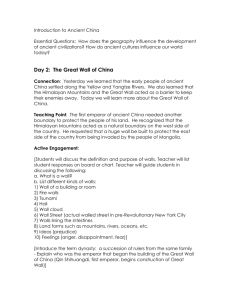Japan Part 1 IG
advertisement
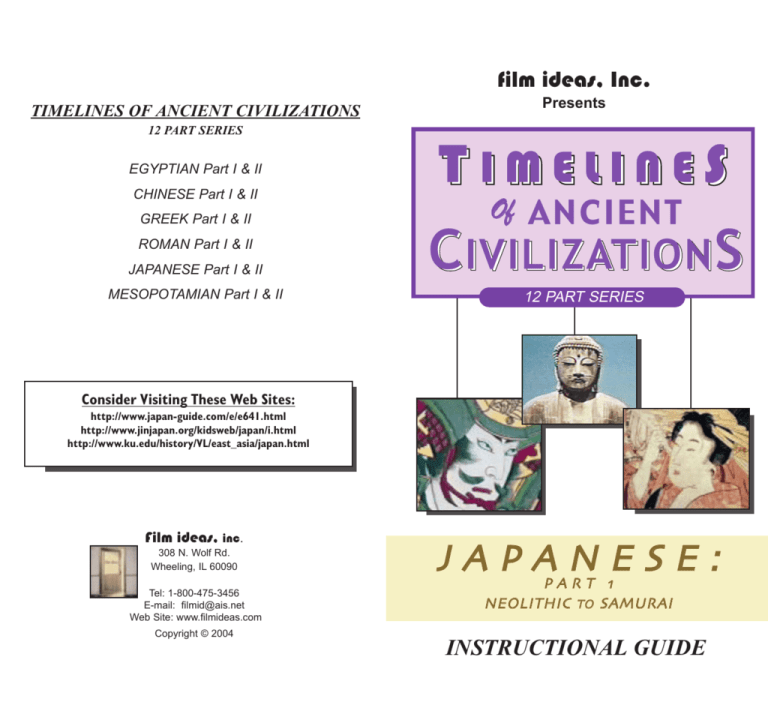
film ideas, Inc. TIMELINES OF ANCIENT CIVILIZATIONS Presents 12 PART SERIES EGYPTIAN Part I & II CHINESE Part I & II GREEK Part I & II TIMELINES Of ANCIENT JAPANESE Part I & II C IVILIZATION S MESOPOTAMIAN Part I & II 12 PART SERIES ROMAN Part I & II Consider Visiting These Web Sites: http://www.japan-guide.com/e/e641.html http://www.jinjapan.org/kidsweb/japan/i.html http://www.ku.edu/history/VL/east_asia/japan.html Film ideas, inc. 308 N. Wolf Rd. Wheeling, IL 60090 Tel: 1-800-475-3456 E-mail: filmid@ais.net Web Site: www.filmideas.com J A P AP A N E S E : RT 1 N E O L I T H I C TO S A M U R A I Copyright © 2004 INSTRUCTIONAL GUIDE INTRODUCTION TO SERIES Study the map on pg. 12. Then write the name of the location on the solid black line. Designed to enhance the social studies curriculum for the intermediate aged student on up. “Timelines of Ancient Civilizations” offers students a unique perspective about the chronological developments of the greatest societies the world has ever known. 4 As a complementary device with each video, an instructional guide suggests exercises to enhance the learning for teachers, parents and students. These interactive exercises will reinforce and further develop a student’s level of comprehension. The instructional guide provides: Vocabulary Biography Chronology / Q & A Discussion Points / Activities Geography 3 2 1 1 2 Permission granted to copy the exercises provided in this guide. For educational use ONLY. 3 4 E-Guides available at www.filmideas.com 13 Study the location of the four main islands of Japan. Then test your geography skills on pg.13. 4 3 2 1 1 KYUSHU: 2 SHIKOKU: 3 HONSHU: 4 HOKKAIDO: 12 JAPAN Of all the ancient civilizations Japan is one of the most unique. Named Nippon or “The Land of the Rising Sun” by the Chinese, Japan, although small in comparison to all of Asia, is a major influence in the region. Located 115 miles off the east coast of the Asian continent, with an area of 145,000 square miles and over 3,000 islands, Japan has developed into one of the world’s greatest cultures. Japan’s early history includes ancient hunters who pursued the mammoth, giant deer, and other animals which roamed the area about 50,000 BCE. After the great ice ages about 20,000 years ago Japan began to separate from the Asian mainland with which it was once connected. By 12,000 BCE Japan has become the island which we know today. During the time Japan became an island off the Asian continent a new era evolved known as the Jomon period. During this period a distinct style of pottery called Jomon developed and improved the migrating lifestyles of the early hunting gathering societies. Later innovations included the cultivation of rice and metals during the Yayoi period. After early settlements Japan entered an age known as feudalism. During this time, a constant state of war existed between local lords and chieftains. By 450 CE the Yamato clan ruled the land. Their reign brought the teachings of Buddhism from Korea and Confucius from China into Japanese society. Eventually in the year 1156, two other families competed for power – the Taira and Minamoto families. After 11 years of brutal fighting the Minamoto family declared victory. Thus the feudal order and class society in Japan was established. The hierarchical structure included the Emperor followed by the Shogun then the Daimyos or warlords and the Samurai warriors. Although the Emperor was first, the Shogun exercised the real power of government through his armies. While the empires of many civilizations have faded from either the introduction of new technologies or the passions of foreign invaders, Japan remains a culture successfully influencing the world by cultivating the antiquities from its unique past with its innovations toward a promising future. 1 V OCABULARY of Japan Part I ARCHIPELAGO: A string of islands which at one time were connected. BUDDHISM: A 5th century BCE religion originating in India.The Yamato clan introduced the religion into Japan after learning about its teachings while attacking settlements located on the Korean Peninsula. By 645 CE these teachings became the official religion in Japan. BUSHIDO: Translated “The Way of the Warrior” and is the strict code of honor observed by the Samurai. CONFUCIUS: Born in 551 BCE he became a popular Chinese philosopher while adopting teachings which centered on gentleness, peace and loyalty. His teachings along with Buddhism were introduced into Japan during the reign of the Yamato clan. DAIMYOS: Warlords who were local land owners. Their status in the feudal order followed the Emperor and Shogun. FEUDALISM: A time period in Japan when constant war existed between local lords and Chieftains. FUJIWARA: A clan which challenged the power of the Emperor during the Heian Period. JAPAN: An island nation with over 3,000 islands and an area of 145,000 square miles located 115 miles off the east coast of Asia. Study the vocabulary words on pgs. 2 & 3. Then fill in the blank by selecting the words from the answers list: ANSWERS LIST : Monolith • Kyoto • Jujitsu • Koi • Daimyos Seppuku • Dharuma • Feng Shui • Ninja • Archipelago A) A string of islands which at one time were connected is known as an . B) Warlords or local land owners known as follow the Emperor and Shogun in the feudal order. C) An imperial home or palace built by Emperor Kammu on the south central Honshu island became known as the . D) is the name given to a ceremonial suicide when a Samurai warrior was disgraced or dishonored. E) A form of karate or fighting without weapons known as was practiced by Samurai warriors to enhance their combat skills. JOMON: A distinct type of pottery made in Japan during the Jomon Period 10,000 BCE-300 BCE. 2 11 Q & A about Japan Part I Study the vocabulary words on pages 2 & 3 and the timeline on pg. 4. Then answer the questions. 1. Confucius became a popular Chinese philosopher. Describe the primary principles Confucius taught. What ruling clan introduced Confucius into Japan? What other religious teachings were introduced into Japan during the same time. 2. How many islands make up the country of Japan? What continent did Japan separate from after the great ice ages? 3. Describe the feudal order and social class which reigned for nearly 700 years after the Minamoto family defeated the Taira family during Japan’s 11 year civil war. 4. Who issued Japan’s first constitution? 5. During Japan’s early history many royal families competed for power. Name two of these royal families and what was their legacy once they achieved power? 6. What is the Chinese name for Japan? 7. What is the name of the emperor’s top general? 8. Describe the training and the code of honor for a Samurai Warrior? 10 JUJITSU: A form of Karate or fighting without weapons. Samurai warriors developed their combat skills through this form of fighting. KOFAN: Funeral mounds and tombs where Chieftains were buried and honored after winning many battles and accumulating much land. KYOTO: An imperial home or palace built by Emperor Kammu on the south central Honshu island. NIPPON: The Chinese name given to Japan. Also meaning “The Land of the Rising Sun”. SAMURAI: Warriors who observed a strict code of honor and loyalty to a land owning war lord who served the Shogun. Highly educated their training included reading, writing, poetry, and performing traditional ceremonial dances. SEPPUKU: The name given to a ceremonial suicide when a Samurai warrior was disgraced or dishonored. SHINTO: Meaning, “The way of the Gods”, and was the name given to the original religion practiced in Japan. Japanese society would later incorporate the teachings of Buddhism and Confucius into their religious practice. SHOGUN: Emperor’s top general who exercised the real power of government through his armies sworn to obey. YAMATO CLAN: One of Japan’s first royal families. During their reign Japan’s first constitution was implemented, the Emperor became the Head of State, and Buddhism became the official religion. 3 T IMELINE of Japan Part I 4 billion years ago: When many scientists believe planet earth began. 200 million years ago: Dinosaurs roamed the earth. 65 million years ago: Dinosaurs extinct. 2 million years ago: Humans began to stand upright and began making tools and weapons. 50,000 BCE - 30,000 BCE: Early Paleolithic Period. Evidence indicates early tribes inhabited Japan. 12,000 BCE: The Islands of Japan separate from the Asian mainland. 10,000 BCE - 300 BCE: The Jomon Period. D iscussion Points /A ctivities 1. Imagine you lived during the time of ancient Japan. Discuss how life would be different than living in the 21st century. 2. A timeline offers a chronological perspective of significant events which have happened throughout history. After viewing the program, study the timeline on pg 4 of this guide, then develop your own timeline which illustrates Japan’s enduring history. Perhaps use the computer; add pictures along with text; if possible develop a multimedia presentation. 3. Japan is famous for feudal order and class society (Emperor, Shogun, Daimyos, Samurai Warriors). Write a brief profile explaining the role of these classes. Use the internet for your research. 300 BCE - 300 CE: The Yayoi Period. 400 CE: A method of character writing established in Japan. 450 CE: The Yamato clan rules Japan. 604 CE: Yamato Prince Shotoku issued Japan’s first constitution. 645 CE: Buddhism becomes the official religion of Japan and taxation is implemented. 784-1185 CE: The Heian Period 1185-1868: The feudal order and class society is established. 1850’s: Americans allowed to visit Japan. 4 4. The science of archeology has provided valuable information about the historic past to the modern-day world. If possible contact an archeologist (preferably one who is an expert on ancient Japan) at a local university, museum or privately funded institution. Ask them to visit your school or arrange a class trip to visit them to explain the importance of archeology. 5. Discuss the differences and similarities between ancient Japan and present-day Japan. Who is the leader of Japan today? What is and was the primary religion practiced in ancient Japan and Japan today? What major industries existed in ancient Japan and Japan today? What is and was the primary means of transportation in ancient Japan and Japan today? What was and is the primary language of ancient Japan and Japan today? etc. 9 G EOGRAPHY Japan of Part I Study the map on pgs. 6 & 7. Then on the solid black line write the name of the location and on a separate piece of paper write a brief description of each location Use the words described in this guide on pgs. 2 & 3 to complete the crossword. 2 4 1 3 6 4 1 5 5 3 2 1 ACROSS: DOWN: 1) Meaning “The Way of the God’s” 2) Meaning “The Land of the Rising Sun”. 3) Constant war between local lords and Chieftains. 2 3 5) Funeral mounds and tombs where Chieftains were buried. 4) Translated “The Way of the Warrior” 6) Emperor’s top general 4 Down -2) Nippon, 4) Bushido, 6) Shogun 5 Across - 1) Shinto, 3) Feudalism, 5) Kofan ANSWERS: 8 5 MAP of Japan Part I Study the modern-day map and its significant locations below. Then test your geography skills on pg. 8. 1 SEA OF JAPAN: The body of water located along Japan’s western border. 2 EAST CHINA SEA: The body of water located 4 along Japan’s southwest border. 1 3 PHILIPPINE SEA: The body of water located 5 along Japan’s southeast border. 4 NORTH PACIFIC OCEAN: The body of water located along Japan’s northeast border. 3 2 5 TOKYO: The capital city of Japan today. 6 7
